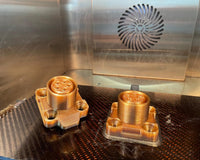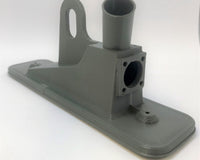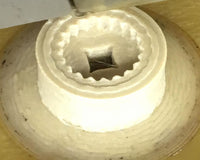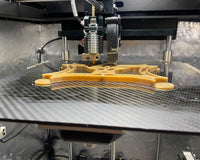Desktop FDM 3D printers are usually able to extrude material up to temperatures of around 280 C. At these temperatures prolonged use will degrade parts such as PTFE nozzle inserts or plastic parts in the build volume. At even higher temperatures stepper motors will fail, as will electronics. Build platform temperatures are also limited to around 100 C. Current generation desktop machines were conceived with filaments such as PLA and ABS in mind. Therefore it is completely sensible that they have been made to operate at the temperatures required for those materials.

A Lulzbot Taz repurposed as a PEEK and PEI high temperature desktop 3D printer.
For the past several years however we've seen people want to extrude Nylons and other higher temperature materials pushing the operating envelope of current desktop machines. We ourselves have created materials such as PPSU, PEEK, PEEK CF, PEKK and PEI (Ultem). These engineering plastics require much higher temperatures to print properly. PPSU requires a bed temperature in excess of 140 C and a nozzle temperature of between 360 and 400 C. PEEK needs a nozzle temperature of between 360 - 420°C (although in some cases it may be closer to 450) and a bed temperature of 120 C. PEI needs a temperature around 340 - 360°C.
High temperature materials such as PEEK, PEI and PPSU bring unheard of performance to desktop 3D printers. The high abrasion resistance, high chemical resistance, low flame, self extinguishing, high strength character of these materials make them the highest performance 3D printing polymers in the market. These materials are especially coveted in research in particular for aviation. Aerospace companies also are using these materials on board air craft. We think that these high temperature materials are the future for manufacturing using 3D printing because of their performance and ability to in some cases replace metals. We are not alone in thinking this and this makes it a material that many researchers want to experiment with.
Up and until now however you had to be lucky enough to have a Fortus printer from Stratasys to be able to extrude these materials coherently. Recently new high temperature 3D printers have come on the market. These boast of better thermal management and resistance to the higher temperatures that these materials need. Is there another path to extruding high temperature materials however?
Two research papers and experimentation by a Ultimaker community member point to an interesting possibility: the use of regular desktop 3D printers to make high temperature materials. Both NASA and Michael McHugh did research in turning a Lulzbot Taz and an Ultimaker 2 into a high temperature PEEK printer.
NASA and the Lulzbot Taz

The new e3D Nozzle.
You can read NASA's paper here. What NASA wanted to do was to make a comparatively low cost printer work for PEI. The team wanted to see if it was possible to upgrade a Lulzbot to do this.
"a central challenge to high temperature printing is maintaining the part temperature during printing. To accomplish this, industrial machines employ a convection oven around the build volume of the printer to maintain the proper build environment [12]. This is not a practical solution on desktop machines for a variety of reasons, including the overall dimensions of the machine and the design of the gantry and extruder systems. Therefore, the system developed and described herein uses directed infrared (IR) heating to focus energy on and control the temperature of only a printed part rather than the entire machine. Doing so keeps the printing environment at a low enough temperature for many of the machine components to maintain structural integrity and function properly. However, some stock components such as electronics, stepper motors, ABS printed machine parts, and hot ends still required modification to ensure survivability and compatibility with the elevated temperatures the machine is exposed to during printing."

The shrouded and protected electronics.
The NASA team made:
- An enclosure for the 3D printer to contain heat.
- They moved the electronics controls out of the printer itself.
- All of the ABS plastic parts on the printer were replaced by 3D printed PEI parts to be able to withstand the higher temperatures.
- They installed a higher temperature hot end, the E3D-v6 1.75 mm Universal
- They added 35W halogen bulbs to produce direct heat.

NASA's halogen bulbs provided part heating.
- An active system and cooling shroud was added to cool the stepper motors and keep them from failing.
- They modified Marlin to let them print at those temperatures.
NASA kept the filament in a special filament box and dried it out before printing. The team was able to print parts without warping and delamination which is one of the problems most people face when working with high temperature materials.

PEI parts 3D Printed on a modified Lulzbot Taz by NASA.
Michael McHugh and the Ultimaker

A double enclosure for this Ultimaker to let it extrude PEEK.
Michael McHugh was also working on similar project. Only he had decided on a much more difficult task to 3D print the notoriously difficult material PEEK. He looked to an Ultimaker 2 and decided to repurpose that machine to turn it into a high temperature printer. In order to do this he aims for achieving a nozzle temperature of "410°C, a heated bed of 130°C and an ambient temperature of 80°C" to print PEEK".

UTS bar 3D printed in PEEK on an Ultimaker.
- He changed the maximum allowed printing temperature in Ulti-flavor of Marlin and in Cura.
- He upgraded the thermistors.
- He then built a double enclosure out of polycarbonate.
- He also upgraded to a e3D hot end.
- He used a hair dryer to heat his parts.

Carabiner test prints on the UM2 with PEEK
He then made a lot of test prints and improved his printer until
" A methodology to test the PEEK FFF printer according to ISO 527 was developed and carried out. The results proved that the capacity to print PEEK using FFF had been successfully developed, and that print specimens had been produced with tensile strengths that compared well to results found in the literature."
You can find Michael McHugh's paper on turning an Ultimaker into a PEEK printer here.

These were his PEEK filament 3D print settings in Cura.
By building a double enclosure he was able to control the heat in his printer and then the hair dryer was sufficient to heat it further.

PEEK Carbiner on the Ultimaker 2
Crema

3D Printing 3D4Makers PEEK on the Ultimaker.
Ultimaker community member Crema also 3D printed in PEEK. He also enclosed his 3D printer but made comparatively few alterations (We've reached out to him to learn more.)
Conclusions
In addition to using high end Fortus production systems and new high temperature desktop 3D printers there is yet a third part to printing high performance engineering plastics: by repurposing desktop 3D printers such as the Ultimaker and Lulzbot to 3D print PEEK and PEI. We applaud any innovation in improving the printability of high temperature materials, out of the goodness of our hearts, and also because we sell PEEK FDM Filament.







7 comments
Knowledge Sourcing
Thanks for sharing such informative content
lack of a skilled workforce, low-cost productivity, and environment-friendly production(favored by the government) are prominent growth factors of the 3D printing market.
for more details visit us
vhttps://www.knowledge-sourcing.com/report/3d-printing-market
3D4Makers team
Thank you Braxton! We added the new link to the paper to the blog post!
Braxton
For those looking for Michaels paper like I was I found a source here: https://pdfkul.com/fffpeekfinal-originalpdf_59d7f9881723ddf891b0fb9e.html
Moin
can someone send me Michale McHughs paper?
Thanks,
Moin.
Ultimaker 3D Printers in India
That’s really great! It might be difficult for people to handle the process but you have done it so nicely. Technology is changing day by day and there are a lot of new techniques regarding 3d printing and scanning that are being introduced. Thank you very much. This will surely help a lot!
Ultimaker 3D Printers in India
Andrew Rolin
Michael McHughs paper was not available. Please send to me.
Sincerely
A. Rolin
Josh
Amazing finally someone who read my mind. I am going into my senior capstone project next year for my BS mechanical engineering degree. I planing doing a research paper on this subject but looks like I’m too late. Maybe all try and raise some capital to build core xy one instead. Thanks for this article I’m sure this is going to be where Desktop FDM printer are going in the next couple years. Then glass infill following the high thermoplastic craze.